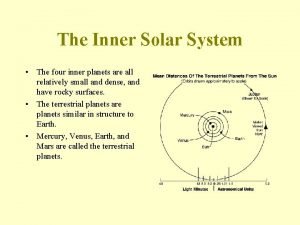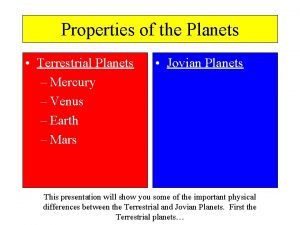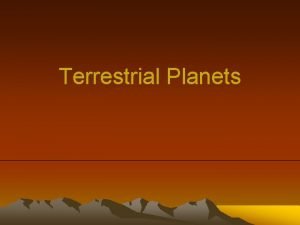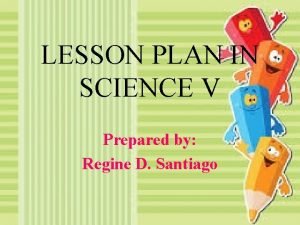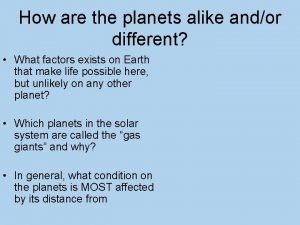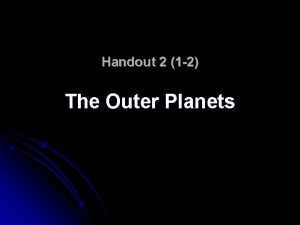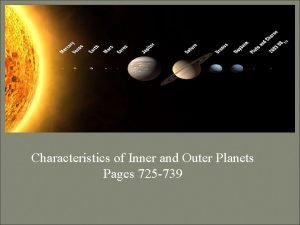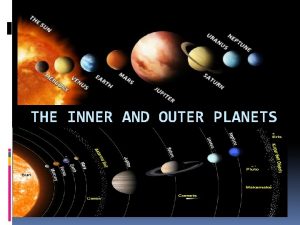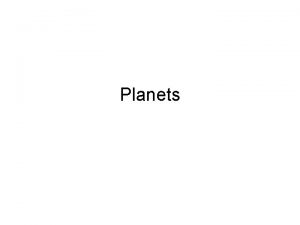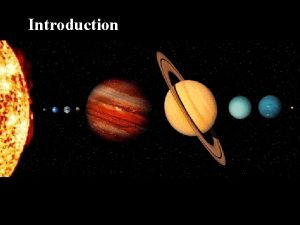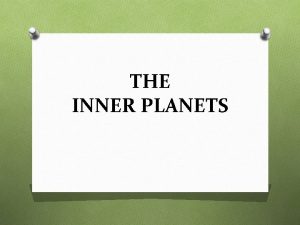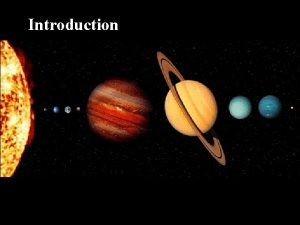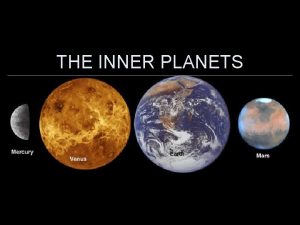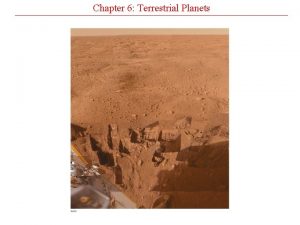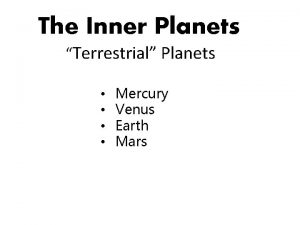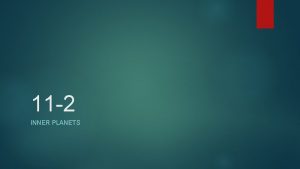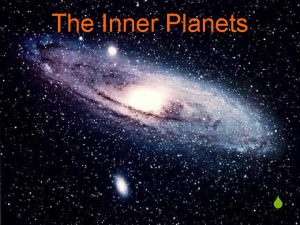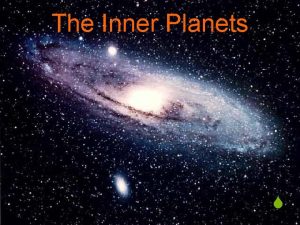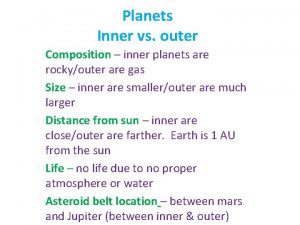Planet Types Terrestrial Planet 0 Inner Four Planets















- Slides: 15

Planet Types Terrestrial Planet 0 Inner Four Planets 0 Closest to the Sun 0 Mercury, Venus, Earth, and Mars 0 Close to the size of Earth 0 Solid, Rocky Surfaces Gas Planet 0 Outer four Planets 0 Farthest from the Sun 0 Jupiter, Saturn, Uranus, Neptune 0 Larger 0 More Gaseous 0 Lack Solid Surfaces

How Do Scientists Know How Our Solar System Formed? 0 Earth Based Studies 0 Use of telescopes in all wavelengths of the electromagnetic spectrum. 0 Data From Probes 0 Scientists Examined 0 1). Why the planets are so different. 0 Especially Outer and Inner Planets 0 2). Asteroids, Meteorites, and Comets.

Formation of Our Solar System Interstellar Clouds 0 Huge Clouds of Dust and Gas in Space 0 Made of Hydrogen and Helium 0 Form Stars and Planets 0 These Interstellar Clouds usually look dark because the dust blocks light. 0 Like Smog 0 Stars behind this cloud can’t shine through it.

Formation of our Solar System Interstellar Cloud 0 But…. Sometimes the light from stars within the cloud causes these interstellar clouds to glow.

Formation of our Solar System Location 0 There are many interstellar clouds found within our Milky Way Galaxy. 0 We look for high amounts of gas and dust. 0 When enough gas and dust is present, scientist think these interstellar clouds will condense because of gravity. 0 Can form a star or planet

Formation of our Solar System Collapsing Interstellar Cloud 0 Cloud begins collapsing slowly. 0 The smaller it gets the faster it begins to collapse and spin 0 This spinning motion with eventually form a rotating disk with a very dense center (core).

Formation of our Solar System 0 Scientist believe that one huge interstellar cloud called the solar nebula formed the Sun and all the planets. 0 The Sun formed first in the center of this cloud. 0 Fits with why our Sun is the brightest most dense thing in our solar system. 0 In the center of the cloud it was the hottest 0 On the edges of the cloud it was the coldest

Formation of our Solar System So What? 0 This difference in temperature as the solar system cooled caused materials to condense and be located in very narrow regions of the solar system 0 This is why we see inner planets and outer planets have such different composition.

Development of Planets 0 Once these materials condense out they begin to collide and stick together. 0 Keep growing larger until they form planetesimals 0 Objects 100’s of km in diameter 0 To produce planets, planetesimals must collide and stick together

Development of Planets Outer Planet Formation 0 1 st planet of the gas to form was Jupiter 0 This is why Jupiter is the largest. 0 Had the most materials to build with 0 Then Saturn and the rest of the gas giants formed 0 Not as large because Jupiter hogged most of the materials; gas, dust, and ice to make itself. 0 Leftovers became Moons

Development of Planets Inner Planet Formation 0 Inner planets were forming from the collision of planetesimals. 0 Made of very different things 0 Sun took all the gas and floating debris away from the inner planets. 0 Why they are rocky and dense 0 Why Moons are rare for inner planets.

Space Rocks 101 Asteroid 0 Leftover pieces of Planetesimals 0 These were never planets 0 Asteroids can collide and break apart.

Space Rocks 101 Meteoroid 0 When an asteroid or any space material falls toward Earth and enters Earth’s atmosphere. Meteor 0 The streak of light produced when a meteoroid burns up in Earth’s atmosphere.

Space Rocks 101 Meteorite 0 When a space object impacts Earth 0 Occurs when all of the meteoroid does not burn up in Earth’s atmosphere 0 Meteor Crater: Arizona 0 Gosses Bluff, Australia

Space Rocks 101 Comets 0 Small icy and rocky bodies with a highly eccentric orbit around the Sun. 0 When Earth is in the way of a comet’s orbit we see a meteor shower
 How are terrestrial planets different from jovian planets?
How are terrestrial planets different from jovian planets? Inner terrestrial planets
Inner terrestrial planets Solar system jeopardy
Solar system jeopardy The inner solar system by leslie
The inner solar system by leslie Inner critic inner defender inner guide
Inner critic inner defender inner guide What are the four outer planets
What are the four outer planets What are the four inner planets
What are the four inner planets Surface of terrestrial planets
Surface of terrestrial planets Characteristics of outer planets
Characteristics of outer planets Solid planets
Solid planets Smallest terrestrial planet
Smallest terrestrial planet Inner outer planets venn diagram
Inner outer planets venn diagram Planet andor
Planet andor Inner planets matching
Inner planets matching Characteristics of inner planets
Characteristics of inner planets What separates the inner and outer planets
What separates the inner and outer planets






